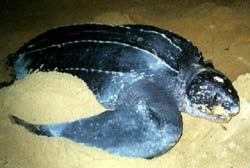The Mediterranean Sea was a desert, millions of years ago. In contrast, the Sahara Desert was once a lush, green landscape dotted with lakes and ponds. Evidence of this past verdancy lies hidden beneath the sands of Egypt and Libya, in the form of a huge aquifer of fresh groundwater. An international team of geologists and physicists has found that this groundwater has been flowing slowly northward (at about the rate grass grows) for the past million years. Their findings have been accepted for March

Scientists at international conference release strategy to save them
The leatherback turtle, a gentle giant weighing close to a ton (907 kg) and measuring eight feet (2.4 meters) in length, may be extinct within a decade in the Pacific Ocean.
The news was released at the 24th Annual Symposium on Sea Turtle Conservation and Biology, a weeklong conference in San Jose, Costa Rica attended by more than 1,000 experts from 70 countries.
Named for its smooth, leathery ski
Provides new look at conservation of threatened coral species
An international research team has identified a family of corals found only in the Atlantic Ocean-a first for such classifications in that ocean-in a study that could transform how corals are viewed and classified. The scientists, who will publish their results in the Feb. 26 issue of the journal Nature, say the findings are also important for future decisions about coral conservation and the preservation of threatened biod
“Nature was nano before nano was cool,” stated Henry Fountain in a recent New York Times article on the proliferation of nanotechnology research projects. No one is more aware of this fact of nature than Dan Morse of the University of California, Santa Barbara. His research groups have been studying the ways that nature builds ocean organisms at the nanoscale for over ten years.
For example, they have studied the abalone shell for its high-performance, super-resistant, composite mineral str
Partners to invest $3.1-mln in marine initiative that encompasses five protected areas & safeguards threatened species in Costa Rica, Panama, Colombia & Ecuador
In one of the most ambitious marine conservation initiatives in the western hemisphere, four Latin American nations, the UNESCO World Heritage Centre, the United Nations Foundation (UN Foundation), Conservation International (CI) and others are consolidating a marine protected area that stretches from Costa Rica to Ecuador and
Global temperatures have increased dramatically over the past century, which is causing major impacts on climate patterns, ocean circulation and wildlife preservation. The increase in temperature is largely due to a rise of anthropogenic emissions of greenhouse gases, of which CO2 is one of the most important.
To understand the capacity of ecosystems to sequester excesses of atmospheric CO2 and improve our ability to predict future climate change scenarios, we must first improve our knowled